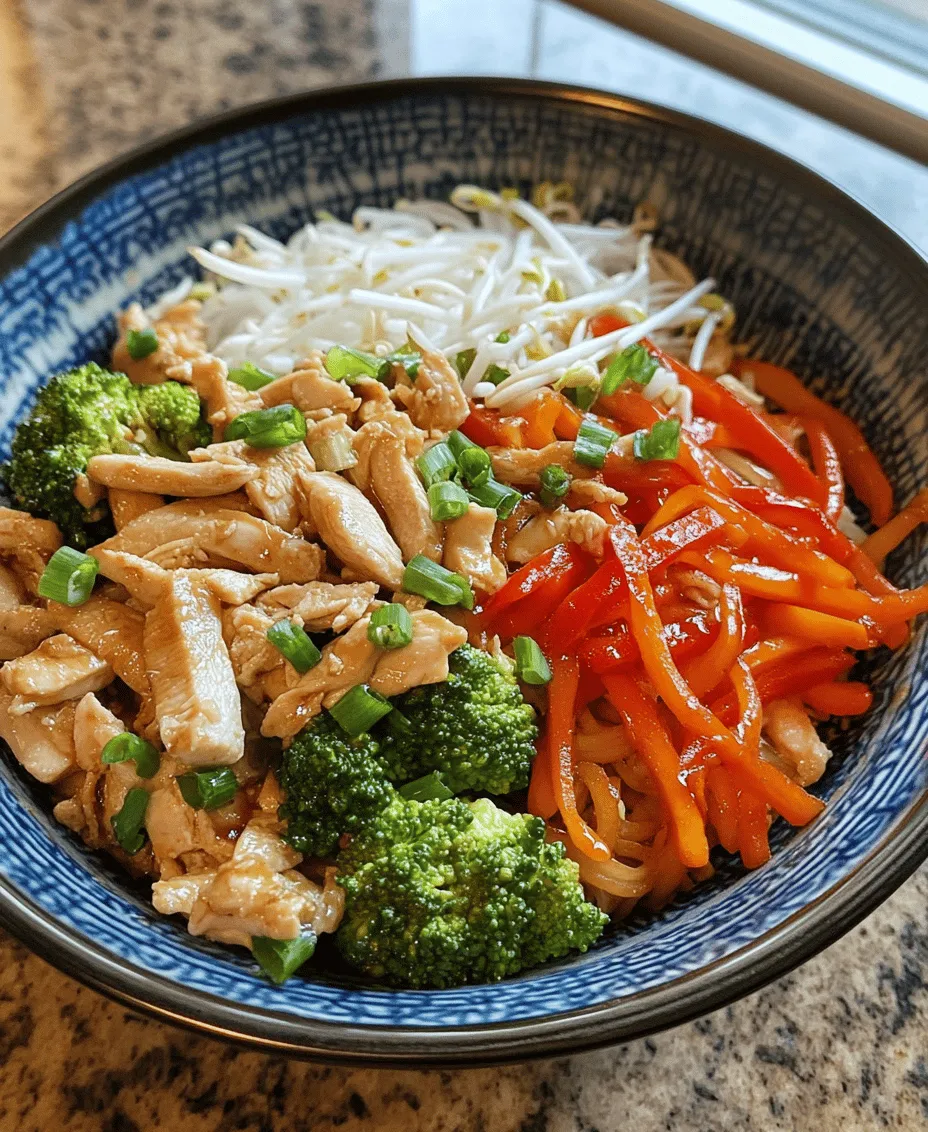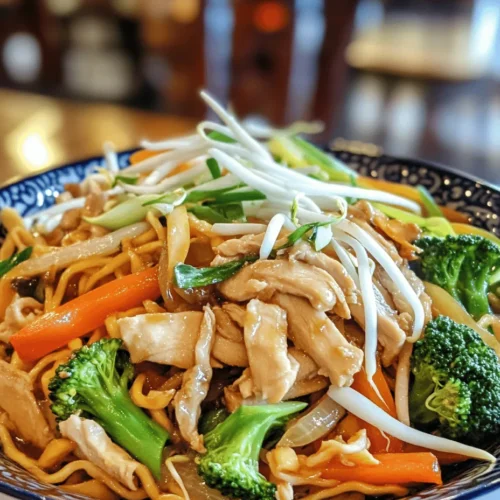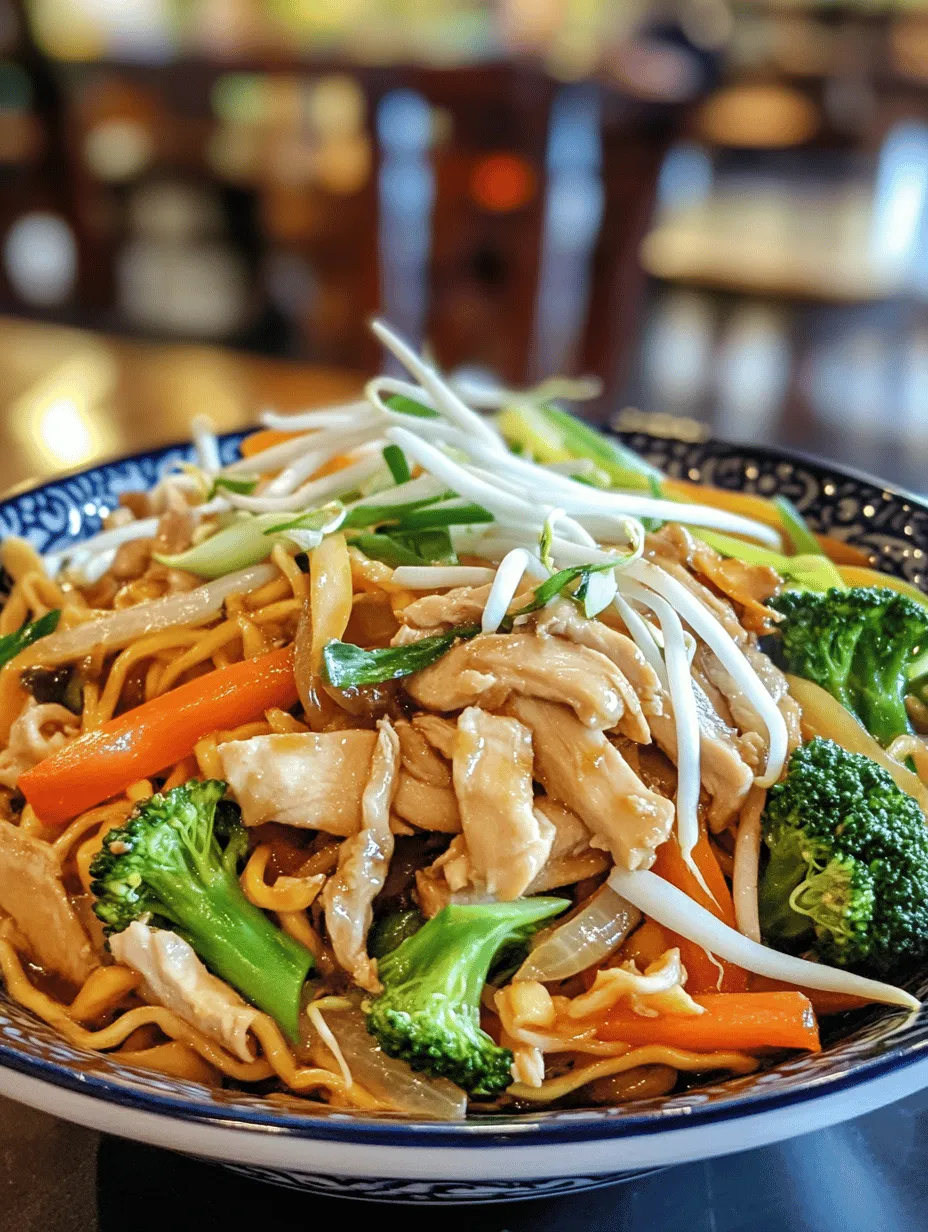Introduction
Chicken Chow Mein is a beloved dish that has captured the hearts and palates of many around the world. This traditional Chinese stir-fry combines tender chicken, crisp vegetables, and chewy noodles, all enveloped in a rich and flavorful chow mein sauce. The vibrant colors and textures of Chicken Chow Mein not only make it visually appealing but also create a delightful symphony of tastes that is both satisfying and comforting.
In recent years, the popularity of homemade versions of this classic dish has surged, and for good reason. When you prepare Chicken Chow Mein at home, you have complete control over the ingredients, allowing you to select the freshest produce and the highest-quality proteins. The process of cooking from scratch also provides a unique sense of accomplishment, knowing you’ve crafted a delicious meal for yourself and your loved ones.
A key component that elevates Chicken Chow Mein is the chow mein sauce. This sauce is crucial in enhancing the overall flavor profile of the dish, tying together all the ingredients in a harmonious blend. With the right combination of soy sauce, oyster sauce, and a hint of sesame oil, you can create a chow mein sauce that will leave your taste buds asking for more. This article will guide you through the process of making Chicken Chow Mein from scratch, including tips on how to achieve the best results.
Understanding Chicken Chow Mein
The origins of Chicken Chow Mein can be traced back to early Chinese immigrants who settled in America. The name “chow mein” itself means “stir-fried noodles” in Cantonese, and the dish has evolved over time to include various ingredients and preparation methods that reflect regional preferences. While its roots lie in Chinese cuisine, Chicken Chow Mein has become a staple in Chinese-American restaurants, often adapted to cater to local tastes.
There are numerous variations of chow mein, each with its unique twist. For instance, some recipes use crispy fried noodles, while others favor softer, steamed noodles. The choice of vegetables can also vary significantly, depending on what is seasonal or available. Regardless of the variation, the core elements of chow mein remain the same: stir-fried noodles, protein, and a medley of vegetables, all brought together with a flavorful sauce.
Common ingredients in Chicken Chow Mein include chow mein noodles, chicken breast, a colorful assortment of vegetables, and, of course, the chow mein sauce. The cooking technique usually involves high heat and quick stir-frying, which helps to lock in flavors and retain the crispness of the vegetables. The result is a dish that is not only delicious but also nourishes the body with a variety of nutrients.
Ingredients Breakdown
To make an authentic Chicken Chow Mein, it’s essential to gather the right ingredients. Below, we break down the primary components that make this dish so special.
Chow Mein Noodles
Chow Mein noodles are the foundation of this dish, providing the chewy texture that complements the other ingredients. There are two main types of chow mein noodles: fresh and dried. Fresh chow mein noodles are typically softer and cook quickly, while dried noodles require boiling before stir-frying. Both types can work well, so choose based on your preference and availability.
When selecting noodles, look for those labeled specifically as chow mein, as they are designed for stir-frying and will hold up well in the cooking process. If you cannot find chow mein noodles, you can substitute them with egg noodles or even spaghetti in a pinch, though the flavor and texture will differ slightly.
Chicken Breast
For the protein component, boneless, skinless chicken breast is the preferred choice due to its lean nature and quick cooking time. Chicken breast can be cut into thin strips or bite-sized pieces, allowing it to cook evenly and absorb the flavors of the sauce. Marinating the chicken briefly before cooking can enhance its flavor and tenderness, making each bite juicy and satisfying.
Vegetables
One of the highlights of Chicken Chow Mein is the colorful array of vegetables that add both nutrition and visual appeal. Here are some commonly used vegetables in the recipe:
– Bell Peppers: Available in various colors, bell peppers add sweetness and crunch. They are also rich in vitamins A and C, making them a nutritious addition.
– Broccoli: This nutrient-dense vegetable provides a nice bite and is an excellent source of vitamins K and C, fiber, and antioxidants.
– Carrots: Their natural sweetness and vibrant orange color bring brightness to the dish. Carrots are high in beta-carotene, promoting good vision and skin health.
– Bean Sprouts: Often used as a garnish, bean sprouts add a fresh, crunchy texture that balances the dish’s flavors. They are low in calories but high in nutrients.
Feel free to customize your vegetable selection based on your preferences or what you have on hand. Other great options include snow peas, bok choy, or mushrooms.
Chow Mein Sauce
The chow mein sauce is the secret weapon that elevates this dish to the next level. A well-balanced sauce combines savory, sweet, and umami flavors, creating a perfect complement to the noodles and vegetables. Here’s a breakdown of the key ingredients that make up a delicious chow mein sauce:
– Soy Sauce: This staple ingredient provides the foundation for the sauce, contributing saltiness and depth of flavor. Opt for low-sodium soy sauce if you’re watching your salt intake.
– Oyster Sauce: Adding a touch of richness, oyster sauce brings a unique umami flavor to the dish. If you follow a vegetarian or vegan diet, look for mushroom-based oyster sauce as a substitute.
– Sesame Oil: A small amount of toasted sesame oil adds a nutty aroma and flavor that enhances the overall dish. Use sparingly, as it can be quite potent.
– Cornstarch: A mixture of cornstarch with water serves as a thickening agent, giving the sauce a glossy finish and helping it cling to the ingredients.
– Sugar: A hint of sugar balances out the saltiness of the soy sauce and the richness of the oyster sauce, creating a well-rounded flavor profile.
By combining these ingredients, you can create a chow mein sauce that is flavorful and satisfying, ensuring that each bite of your Chicken Chow Mein is a delightful experience.
Preparation Steps
Now that you have a deeper understanding of Chicken Chow Mein and its ingredients, it’s time to dive into the preparation steps. Follow this detailed guide to create your own Chicken Chow Mein at home:
1. Prepare the Ingredients: Begin by gathering all the ingredients and equipment you will need. This includes chopping the chicken breast into thin strips, slicing the vegetables, and measuring out the ingredients for the chow mein sauce. Having everything ready will streamline the cooking process.
2. Marinate the Chicken: In a bowl, combine the sliced chicken with a tablespoon of soy sauce and a teaspoon of cornstarch. Mix well and let it marinate for about 15-20 minutes. This step infuses the chicken with flavor while helping it stay tender during cooking.
3. Cook the Noodles: If using dried chow mein noodles, cook them according to the package instructions until al dente. Drain and rinse them under cold water to stop the cooking process. If using fresh noodles, you can skip this step.
4. Prepare the Chow Mein Sauce: In a small bowl, whisk together the soy sauce, oyster sauce, sesame oil, sugar, and cornstarch mixed with water. Set aside for later use.
5. Stir-Frying: Heat a large wok or non-stick skillet over high heat. Add a tablespoon of vegetable oil and swirl it around to coat the pan. Once hot, add the marinated chicken and cook, stirring frequently, until it’s golden brown and cooked through, usually around 4-5 minutes. Remove the chicken from the pan and set it aside.
6. Cook the Vegetables: In the same pan, add another tablespoon of oil if needed. Add the vegetables in order of cooking time, starting with the carrots and broccoli, followed by bell peppers and bean sprouts. Stir-fry for about 3-4 minutes until the vegetables are tender-crisp.
7. Combine All Ingredients: Return the chicken to the pan with the cooked vegetables. Pour the chow mein sauce over the mixture and toss everything together. Continue to cook for another 2-3 minutes, allowing the sauce to thicken and coat all the ingredients.
8. Add the Noodles: Finally, add the cooked chow mein noodles to the pan. Gently toss everything together until the noodles are evenly coated with the sauce, and heat through for an additional minute.
Now that you have all the initial steps laid out, you are well on your way to enjoying a delicious homemade Chicken Chow Mein. The combination of tender chicken, fresh vegetables, and the savory chow mein sauce will surely impress your family and friends. Stay tuned for the next part, where we will explore tips for achieving the best results and answer some common questions about this delightful dish.

Cooking the Noodles
To achieve perfectly cooked chow mein noodles, start by bringing a large pot of water to a rolling boil. Add the chow mein noodles and cook according to the package instructions, typically around 3-5 minutes for fresh noodles or 5-7 minutes for dried noodles. The goal is to have the noodles al dente; they should be tender but still have a slight bite to them.
Once the noodles are cooked, drain them in a colander and immediately rinse them under cold water. Rinsing is crucial as it stops the cooking process and helps remove excess starch that can cause the noodles to clump together. After thoroughly rinsing, toss the noodles with a small amount of oil to prevent sticking. This step will ensure your chow mein noodles remain separate and easy to stir-fry later in the recipe.
Creating the Sauce
The chow mein sauce is the heart of the dish, providing a complex balance of flavors that elevates the entire meal. Start by combining soy sauce, oyster sauce, and a splash of sesame oil in a bowl. These ingredients create the umami base of the sauce. For a touch of sweetness, add some sugar or honey.
To thicken the sauce, mix in cornstarch with a small amount of water to create a slurry. This will help ensure that the sauce clings beautifully to the noodles and chicken without being overly runny. Whisk all the ingredients together until well combined. Taste the sauce and adjust as needed – you may prefer a bit more soy sauce for saltiness or more sugar for sweetness, depending on your personal preference.
Cooking the Chicken
For juicy and flavorful chicken, it’s essential to use high-quality boneless, skinless chicken breast or thighs. Cut the chicken into thin strips, which will allow for quick cooking and better absorption of the chow mein sauce.
When it’s time to stir-fry, make sure your wok or frying pan is preheated on high heat. Add a tablespoon of oil and swirl it around to coat the pan. Add the chicken strips in a single layer, allowing them to sear without overcrowding. This step is vital as overcrowding can steam the chicken instead of giving it a nice golden-brown color. Stir-fry for about 3-4 minutes or until the chicken is fully cooked and no longer pink in the center. Once done, remove the chicken from the pan and set it aside while you prepare the vegetables.
Sautéing the Vegetables
When cooking chow mein, timing is everything, especially when it comes to the vegetables. Start by adding aromatics like minced garlic and ginger to the hot pan, stirring for about 30 seconds until fragrant. Next, add your choice of vegetables. A combination of bell peppers, carrots, and snap peas works wonderfully, but you can use any vegetables you enjoy.
Cook the vegetables for about 2-3 minutes, stirring frequently to maintain their vibrant colors and crispness. The goal is to have them tender but still slightly crunchy, providing a nice contrast to the noodles and chicken. If you’re using broccoli or other denser vegetables, consider adding them a minute earlier to ensure they cook evenly.
Combining Ingredients
Once your chicken and vegetables are cooked, it’s time to bring everything together. First, add the cooked chow mein noodles to the pan, followed by the stir-fried chicken and the prepared chow mein sauce. Use tongs or a spatula to gently toss all the ingredients together, ensuring that the sauce evenly coats the noodles, chicken, and vegetables.
Make sure to mix thoroughly but gently to avoid breaking the noodles. This step is crucial for ensuring that each bite is flavorful and well-balanced. If the mixture seems too dry, feel free to add a splash of water or more sauce to reach your desired consistency.
Final Touches
The final touch to elevate your Chicken Chow Mein is the addition of fresh bean sprouts. These delicate sprouts should be added last, right before serving. Toss them in briefly, just enough to warm them without losing their delightful crunch. This finishing touch adds texture and freshness to the dish, making every bite a delightful experience.
Nutritional Insights
Chicken Chow Mein is not only delicious but also nutritionally balanced. With a good mix of protein from the chicken, carbohydrates from the noodles, and essential vitamins from the vegetables, it makes for a wholesome meal. A typical serving of Chicken Chow Mein offers around 400-500 calories, depending on the portion size and specific ingredients used.
For those looking to modify the recipe for dietary preferences, you can easily substitute chicken with tofu for a vegetarian option. Additionally, using whole wheat or gluten-free noodles can accommodate various dietary restrictions without sacrificing flavor.
Serving Suggestions
When it comes to serving Chicken Chow Mein, presentation can enhance the meal experience. Consider garnishing your chow mein with toasted sesame seeds or thinly sliced green onions for a pop of color and flavor.
Pairing your chow mein with other dishes can create a well-rounded meal. Spring rolls or potstickers make fantastic appetizers, while a bowl of hot and sour soup can complement the flavors of the chow mein beautifully.
For a refreshing finish, serve a side of pickled vegetables or a light cucumber salad to cleanse the palate.
Conclusion
Making Chicken Chow Mein at home is a rewarding culinary adventure, allowing you to control the flavors and ingredients while enjoying a beloved classic. The versatility of this dish means you can adapt it to your taste preferences, whether you prefer more protein, extra vegetables, or even a different type of noodle.
The chow mein sauce is essential to unifying the dish, making it a staple in your culinary repertoire. Remember, cooking is not just about following a recipe but about making it your own. Embrace the process, experiment with ingredients, and enjoy the satisfaction of crafting a delicious meal from scratch. So gather your ingredients, fire up that wok, and indulge in the delightful experience of homemade Chicken Chow Mein.



